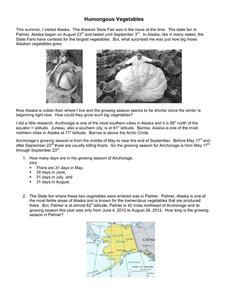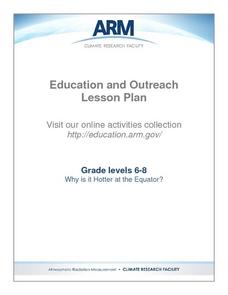Curated OER
Complex Analysis: Cauchy's Residue Theorem
In this residue theorem worksheet, students find the poles of a function classify all singularities of a function, and compute the residues of that function. This two-page worksheet contains explanations and examples, as well as five...
Curated OER
Festivals and Fairs
Students celebrate May Day. In this Medieval festivals lesson, students research May Day and information about may poles. Students build their own may poles and discuss the significance of the May Day festival.
Curated OER
Magnets
In this magnets worksheet, 4th graders will complete two statements about what happens when magnets of like poles are put together compared with magnets of unlike poles.
Curated OER
Ice-Fishing
Students go ice-fishing. In this magnet lesson students use magnetic fishing poles at the sensory table. the sensory table is full of cotton balls. They find magnetic numbers that have been hidden.
Curated OER
Tree and Pole
In this algebra worksheet, students calculate the length and ratio of two objects, as they relate to each other, when solving this word problem. There is an answer key.
Curated OER
Barber Pole
In this geometry learning exercise, learners calculate the length of the rotating stripes around a cylinder. There is an answer key with this problem.
Curated OER
Ozone and Temperature Data Analysis, South Pole Antarctica
High schoolers discuss the layers of the atmosphere, and the history of the ozone hole. They discuss the chemistry of the ozone formation. Students compare seasonal data collected with ozonesondes. They compare Antarctic and Arctic ozone...
Curated OER
Finding the Pole Star
Students study the constellations fo the Big Dipper and Cassiopeia and their use in finding the Pole Star. They realize that other celestial objects--Sun, Moon and planets--share the rotation (and hence rise and set), even though their...
Curated OER
Our Goal Pole
Studnets discuss the meaning of exploration and investigate a map of the Louisiana Territory. They discuss Lewis and Clark's expedition and complete worksheets. They create a "goal pole" that represents their learning.
Curated OER
The Shadow Knows - Measuring A Telephone Pole
Third graders attempt to determine the height of a telephone pole or tree without climbing to the top.
Curated OER
Do Some Research: Earth
For this universe research worksheet, students read the sentence and use a library or the Internet to find the answer and write it on the blue line. Students must then write a report about this topic: the ____ regions are the area around...
Curated OER
Picture Prompt: Elf at the North Pole Village
Great during the Christmas season, this prompt gives students a picture of an elf in the North Pole Village to inspire students to begin and end the story. A word box provides teachers the opportunity to add words from a spelling or...
Curated OER
Magnetism
All phenomena concerning magnets, their field lines and impact on objects are covered. The trivia surrounding field lines and the earth, electric charges, repulsion and attraction is plentiful. The slide show continues after twenty...
CK-12 Foundation
Walk the Tightrope
Why do many tightrope walkers use a balancing pole? The simulation explores the benefits of balancing poles and the features that are most important. Pupils control the pole length, pole mass, pole stiffness, and the initial angle of...
Curated OER
Magnet Mania
Youngsters go on a magnetic fishing trip! Use an engaging and clever language arts lesson to reinforce the recognition of the letters of the alphabet with very young readers. A fishing pole is made of a ruler and a piece of string with a...
Curated OER
Humongous Vegetables
Humongous vegetables can inspire and awaken your mathematicians to the large math concepts in our Common Core standards. What is the secret to growing such gargantuan garden objects in Alaska? In the state that is closest to the North...
What So Proudly We Hail
The Meaning of America: Freedom and Religion
The United States of America was founded on firm ideals of both the pursuit of happiness and a spirit of reverence. Through a close reading of Nathaniel Hawthorne's "The May-Pole of Merry Mount," you can examine what some consider was a...
Scholastic
Study Jams! Magnetism
Six simple images pull your class into magnets. Most of the pictures show magnetic fields as revealed by iron filings. Concepts are explained in print along the bottom of each slide and include magnetic force, force fields, poles,...
University of Colorado
Terra Bagga
Earth's magnetic poles switch positions about every 200,000—300,000 years. In the activity, groups create a planet with a magnetic field. Once made, they use a magnetometer to determine the orientation of the planet's magnetic field....
CK-12 Foundation
Coriolis Effect: Flying... South?
It turns out there's a lot more to heading south for the winter for migratory birds! Study the Coriolis Effect with a fun, hands-on teaching tool. Pupils take to the skies as a small red bird bound for the tropics from his frosty home at...
Concord Consortium
Polar and Non-Polar Interface
Why is there so much frozen water at Earth's poles? Because water is a polar molecule! Young scientists observe polar molecules moving in a mixture of oil and water. They see the changes in potential energy in the hydrophilic and...
GLOBE Program
Calculating Relative Air Mass
Combine math and science with fun in the sun! Scientists build a solar gnomon using reusable materials to calculate relative air mass. Mathematicians measure the pole's shadow and use the data to solve for relative air mass....
Curated OER
Celebrate May Day this Spring
Welcome spring as you explore various traditions for celebrating May Day.
Curated OER
Why Is It Hotter At the Equator?
Pupils investigate the different heating effects of sunlight. They conduct an experiment that demonstrates the way sunlight strikes the equator, the poles and other parts of the globe.
Other popular searches
- Totem Poles
- Magnetic Poles
- North and South Poles
- Magnetism and Poles
- American Indians Totem Poles
- Paper Mache Totem Poles
- Art Totem Poles
- Native American Totem Poles
- Magnet Poles
- Like Poles Attract
- Poles, Parallels, Primes
- Totems and Story Poles
























